 Facebook
Facebook
 X
X
 Instagram
Instagram
 TikTok
TikTok
 Youtube
Youtube

Imagine a near-future trip to a central San Diego neighborhood reshaped by the zoning plans proposed by Mayor Kevin Faulconer. 12-story buildings line 30th Street, University Avenue and El Cajon Boulevard – and up to Adams Avenue.
The apartment buildings spill around the corners on those main drags, and because of previous city council efforts, do not include parking. The buildings first appear on the largest existing lots – with the maximum size now decided by floor area ratio, so that a 12,001 square-foot lot can have that many stories – without having to consider the will of the neighborhood.


That’s what the Complete Communities plan that redefines zoning to encourage building new housing will allow. For example, the half block lot that now has a Vons store at 30th Street between Howard and Polk (and which sold to developers for $27.7 million earlier in May) can go a full 12 stories. But so can the lots across the street if two or three are combined – and developers will be allowed to do that.
Many streets within a block of those thoroughfares have double-Huffmans or several in a row; it’s a building design very common in North Park and Normal Heights. A developer that can buy adjacent Huffman lots and combine the square footage into area large enough to build tall buildings in older, single family and small apartment or condo complex neighborhoods all over the central part of the city from Barrio Logan to Mission Valley, and from Midway to the College area. San Ysidro is almost entirely transit priority area as well.
They face a relaxed city approval process both from the city and they don’t have to win public approval. And with floor-area ratio as the new standard, and using the bonuses the plan offers, developers can build tall buildings next to single-family homes.
They do have to meet requirements beyond the current density bonuses that, for example, are allowing developers to build a 20-story building on the west side of Balboa Park. The percentage of units that must be affordable jumps to 20 from the current 10 percent. And they must be in what the city calls “transit oriented” districts, which is almost any area along major bus lines.
But the hardest thing for neighborhood representatives from across the city who met Tuesday night to swallow is the speed with which the plan is being pushed through.
It goes to the city council for approval sometime in the next month. Many of the groups have been unable to meet or hold elections since the lockdown. Public input on the plan has been very limited, they say.
“It ought to be referred back to the planning department and go out to planning groups so they can weigh in on the advisability of these policy decisions,” said Howard Wayne, representing Linda Vista.
Community Planners chairman Wally Wulfeck said that what’s happened during the pandemic should be considered in current and future development decisions. In San Diego, as in cities with much higher numbers of people sickened and killed by COVID 19, denser and poorer neighborhoods are suffering the worst of the pandemic.
“The experience of the last three months has illustrated the problems with density and the problems with mass transit, and I think we ought to think carefully about putting low income people in these high density areas,” Wulfeck said.
The pandemic will slash government funding needed to build more infrastructure – which developers do not have to pay for, according to Nico Calavita, who calls the plan “a reckless approach.”
“These densities are being proposed in “transit priority” areas,” he wrote in a letter to the city. “But where is the transit?.......In a post-COVID19 economic reality, funding from the federal government or state is very unlikely. Additionally, with COVID19, the desirability and feasibility of transit has taken a hit.”
That’s a particularly thorny problem since the city does not control transit – and both the Metropolitan Transit System and SANDAG have no extra funding and need voter approval to raise money.
Though the plan was introduced months ago, it was months before anyone took a close look at the details; in part because the document is so hard to decipher, Calavita says.
Zoning maps reduce neighborhoods to codes – single family and multifamily, come in at R-1 and R 3-9, for example. Another, separate document contains the translations for the zoning and the mayor’s proposed regulations for how much can be built on those lots.
The plan ends transitional zoning, where heights and density change gradually so that tall buildings don’t tower over tiny homes. “They could actually be large scale buildings,” said Deborah Sharp. “And it would eliminate the community input.”
The sweeping relaxation of development rules and zoning is only meant to encourage small infill projects, says Leslie Keaveney of the city planning staff. If the project meets the relaxed city standards, approval is a development services department decision not subject to neighborhood review, though people can comment. The developer impact fee, meant to shore up amenities in neighborhoods – libraries, green spaces, infrastructure – may go away, too if there’s enough affordable housing in the project.
“The main goal of this program is to incentivize housing,” said Brian Schoenfrisch, from the city. “Right now we would have to triple our housing production to meet our housing goals. This is tailored to meet our local needs.”
But Andrea Schlageter from Ocean Beach pointed out that a city that needs 30,000 new homes shouldn’t tolerate 16,000 short-term rentals, something she says the city ignores.
“Every time we talk about housing, you guys just go to developers and ask them what do they want us to give them now,” she said. “You keep saying ‘holistic approach’ which means top down approach. What that approach means is taking money from the suburbs and putting downtown.“
Under pressure to approve the plan, the neighborhood representatives balked. “It ought to be referred back to the planning department and go out to planning groups so they can weigh in on the details,” said Howard Wayne, representing Linda Vista.
Floor area ratio is emerging as a way to assess a project while granting a building permit. It is derived by dividing the gross floor space by the lot size; so the allowable floor space is equal to the proposed floor area ratio set by the city multiplied by the size of the lot. With a floor area ratio of eight, all the bonuses and a 12,000 square foot lot, the developer can build up to 96,000 square feet – but in the buildable part of the lot, that’s eight stories.


Imagine a near-future trip to a central San Diego neighborhood reshaped by the zoning plans proposed by Mayor Kevin Faulconer. 12-story buildings line 30th Street, University Avenue and El Cajon Boulevard – and up to Adams Avenue.
The apartment buildings spill around the corners on those main drags, and because of previous city council efforts, do not include parking. The buildings first appear on the largest existing lots – with the maximum size now decided by floor area ratio, so that a 12,001 square-foot lot can have that many stories – without having to consider the will of the neighborhood.


That’s what the Complete Communities plan that redefines zoning to encourage building new housing will allow. For example, the half block lot that now has a Vons store at 30th Street between Howard and Polk (and which sold to developers for $27.7 million earlier in May) can go a full 12 stories. But so can the lots across the street if two or three are combined – and developers will be allowed to do that.
Many streets within a block of those thoroughfares have double-Huffmans or several in a row; it’s a building design very common in North Park and Normal Heights. A developer that can buy adjacent Huffman lots and combine the square footage into area large enough to build tall buildings in older, single family and small apartment or condo complex neighborhoods all over the central part of the city from Barrio Logan to Mission Valley, and from Midway to the College area. San Ysidro is almost entirely transit priority area as well.
They face a relaxed city approval process both from the city and they don’t have to win public approval. And with floor-area ratio as the new standard, and using the bonuses the plan offers, developers can build tall buildings next to single-family homes.
They do have to meet requirements beyond the current density bonuses that, for example, are allowing developers to build a 20-story building on the west side of Balboa Park. The percentage of units that must be affordable jumps to 20 from the current 10 percent. And they must be in what the city calls “transit oriented” districts, which is almost any area along major bus lines.
But the hardest thing for neighborhood representatives from across the city who met Tuesday night to swallow is the speed with which the plan is being pushed through.
It goes to the city council for approval sometime in the next month. Many of the groups have been unable to meet or hold elections since the lockdown. Public input on the plan has been very limited, they say.
“It ought to be referred back to the planning department and go out to planning groups so they can weigh in on the advisability of these policy decisions,” said Howard Wayne, representing Linda Vista.
Community Planners chairman Wally Wulfeck said that what’s happened during the pandemic should be considered in current and future development decisions. In San Diego, as in cities with much higher numbers of people sickened and killed by COVID 19, denser and poorer neighborhoods are suffering the worst of the pandemic.
“The experience of the last three months has illustrated the problems with density and the problems with mass transit, and I think we ought to think carefully about putting low income people in these high density areas,” Wulfeck said.
The pandemic will slash government funding needed to build more infrastructure – which developers do not have to pay for, according to Nico Calavita, who calls the plan “a reckless approach.”
“These densities are being proposed in “transit priority” areas,” he wrote in a letter to the city. “But where is the transit?.......In a post-COVID19 economic reality, funding from the federal government or state is very unlikely. Additionally, with COVID19, the desirability and feasibility of transit has taken a hit.”
That’s a particularly thorny problem since the city does not control transit – and both the Metropolitan Transit System and SANDAG have no extra funding and need voter approval to raise money.
Though the plan was introduced months ago, it was months before anyone took a close look at the details; in part because the document is so hard to decipher, Calavita says.
Zoning maps reduce neighborhoods to codes – single family and multifamily, come in at R-1 and R 3-9, for example. Another, separate document contains the translations for the zoning and the mayor’s proposed regulations for how much can be built on those lots.
The plan ends transitional zoning, where heights and density change gradually so that tall buildings don’t tower over tiny homes. “They could actually be large scale buildings,” said Deborah Sharp. “And it would eliminate the community input.”
The sweeping relaxation of development rules and zoning is only meant to encourage small infill projects, says Leslie Keaveney of the city planning staff. If the project meets the relaxed city standards, approval is a development services department decision not subject to neighborhood review, though people can comment. The developer impact fee, meant to shore up amenities in neighborhoods – libraries, green spaces, infrastructure – may go away, too if there’s enough affordable housing in the project.
“The main goal of this program is to incentivize housing,” said Brian Schoenfrisch, from the city. “Right now we would have to triple our housing production to meet our housing goals. This is tailored to meet our local needs.”
But Andrea Schlageter from Ocean Beach pointed out that a city that needs 30,000 new homes shouldn’t tolerate 16,000 short-term rentals, something she says the city ignores.
“Every time we talk about housing, you guys just go to developers and ask them what do they want us to give them now,” she said. “You keep saying ‘holistic approach’ which means top down approach. What that approach means is taking money from the suburbs and putting downtown.“
Under pressure to approve the plan, the neighborhood representatives balked. “It ought to be referred back to the planning department and go out to planning groups so they can weigh in on the details,” said Howard Wayne, representing Linda Vista.
Floor area ratio is emerging as a way to assess a project while granting a building permit. It is derived by dividing the gross floor space by the lot size; so the allowable floor space is equal to the proposed floor area ratio set by the city multiplied by the size of the lot. With a floor area ratio of eight, all the bonuses and a 12,000 square foot lot, the developer can build up to 96,000 square feet – but in the buildable part of the lot, that’s eight stories.
Comments